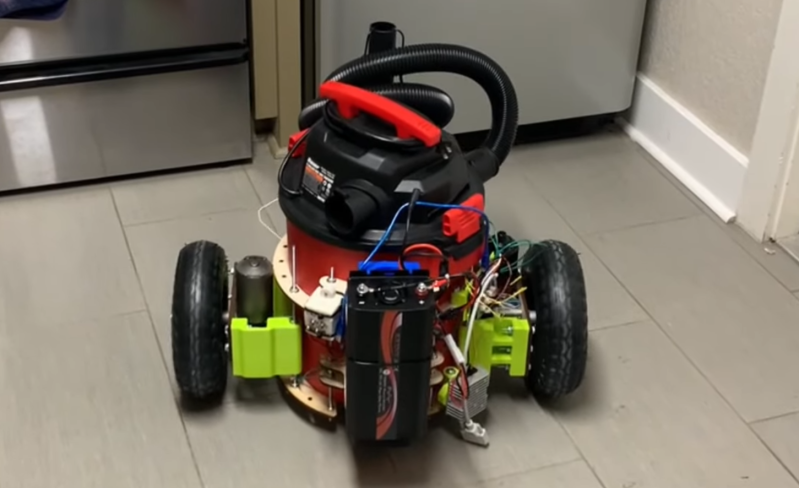The robotic revolution is currently happening, although for the time being it seems as though most of the robots are still being generally helpful to humanity, whether that help is on an assembly line, help growing food, or help transporting us from place to place. They’ve even showed up in our homes, although it’s not quite the Jetsons-like future yet as they mostly help do cleaning tasks. There are companies that will sell things like robotic vacuum cleaners but [Clay Builds] wanted one of his own so he converted a shop vac instead.
The shop vac sits in a laser-cut plywood frame and rolls on an axle powered by windshield wiper motors. Power is provided from a questionable e-bike battery which drives the motors and control electronics. A beefy inverter is also added to power the four horsepower vacuum cleaner motor. The robot has the ability to sense collisions with walls and other obstacles, and changes its path in a semi-random way in order to provide the most amount of cleaning coverage for whatever floor it happens to be rolling on.
There are a few things keeping this build from replacing anyone’s Roomba, though. Due to the less-than-reputable battery, [Clay Builds] doesn’t want to leave the robot unattended and this turned out to be a good practice when he found another part of the build, a set of power resistors meant to limit current going to the vacuum, starting to smoke and melt some of the project enclosure. We can always think of more dangerous tools to attach a robotic platform to, though.















I’m interested in understanding how vacuum power is calculated. Four horsepower seems incredible. I can see that significantly higher power shop vacuums are sold in the Bauer range.
Oh that’s easy, they lie. IIRC they use the first couple millisecond motor inrush, or if you lock the rotor and stall the motor. Of course this would blow the motor up instantly, but technically for a second, it is making 4hp. A normal outlet is only sustained 1800w / 2.4hp? so anything more than that is a lie. But, how many vacuums would you sell if you wrote the honest 1.5hp vs the marketing 5hp on it?
We used to call it Sears horsepower B^)
Those are PMPO horses.
Yep, it’s incredible – it isn’t credible at all. In reality this one may be less than one horsepower output, given it consumes 120V * 8A max continuous and is probably using an inefficient type of motor.
In the US most hand power tools and shop vacs use “universal motors” (cause they can run on AC or DC) and when I was a kid they typically were labeled ‘… develops up to X Hp’ if as mentioned above you just use inrush current…
I’m amazed to find out that I apparently don’t know whether this harbor freight product, which is labeled as 120V 8A on the sticker, might be mysteriously underrating itself and instead using an expensive 240V inverter VFD despite being a $50 product with no visible speed control beyond off and on.
Or maybe it uses a brushed universal motor. You know, the kind that is inefficient but very convenient for compact, high speed power output from 120V mains, and so is very common in handheld power tools. At least when they’re not battery powered brushless DC motors, anyway.
Ive long envisioned a shop vac whose wheels’ sole job was to swivel such that the machine didn’t get tangled or tripped up by its own cord.
And THAT is my $1,000,000 gift to the world.
We call our Roomba “Biden”, because it wanders around bumping into things.
R2D2 in Drag?
Needs an automatic tool changer.